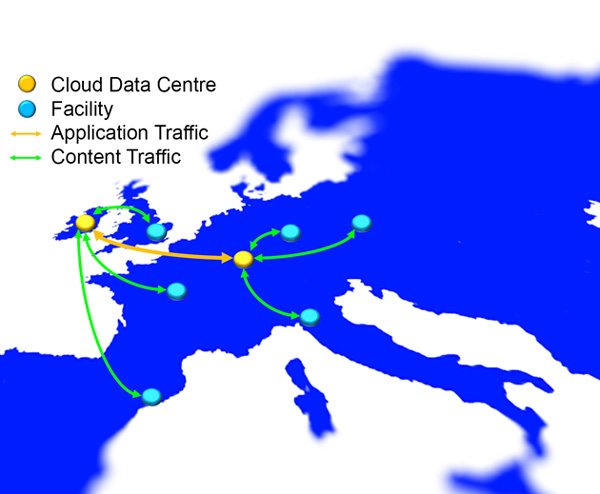Broadcast News
09/01/2015
More Glue Or Fewer Pieces? (Part 2)

continued from part 1...
This is particularly true in the case of cloud services. Many businesses are moving systems from their own infrastructure to cloud hosted equivalents. This may be fine for e-mail, human resources, or customer relationship management (CRM) systems.
However, when it comes to media, the hurdles are higher and more numerous. Security must be at the top of the priority list: Is the application safe? Is your connection to it safe? Most importantly, is your content safe – both in transit and in storage?
In moving to the cloud, organisations have had to evolve their security from the physical risks of theft and protecting closed networks to the intangible threats of an open network and the internet. Connectivity is also high on the list of concerns for cloud technology, and again there are many facets. Speed is king, and that doesn't just rely upon the bandwidth of the pipe.
The connections provisioned with the cloud provider, transfer systems used, security around transfer as well as the place in the workflow the cloud solution sits are factors as well. Is it dealing with source, uncompressed, mezzanine, or delivery files? This evolves naturally to the question of applications. Currently there are many media services available from dailies to visual effects (VFX), to colour grading, editing, mastering, transcoding and delivery. In theory, it is possible to travel from camera to screen using cloud services alone for processing. In truth, this is currently prohibitively complex for a production of scale as it would involve multiple hops between different clouds, myriad file format swaps and difficult, often manual transfer of metadata.
Organisations with multiple facilities, across geographies, have a compelling advantage to working locally while having a central resource. In this scenario, each facility may be small yet nimble. These facilitates have the ability to pool resources by having a single collaborative platform, allowing the advantages of a centralised resource without compromising the local tailored service. They are able to come together for large projects while still leveraging niche expertise within the group, and also easily work independently on smaller more local projects.
In this pan-European example (above), a single entity with multiple facilities can leverage skillsets in each territory, as well as being network efficient between facilities and the cloud, by spanning the cloud application across data centres.
There are many ways to achieve remote access to central hardware resources, for example keyboard, video and mouse over IP (KVMoIP), or a software virtual machine control over wide area network (WAN). The cloud offers this type of capability with the advantage of eliminating the need to build the network and infrastructure while being totally elastic. The lack of full suite of integrated media services for cloud means that currently this approach is not an off-the-shelf solution. The breadth of applications is on the rise, yet media processing services in the cloud still lack interoperability.
Current attempts to integrate applications in cloud environments generally revolve around application programming interfaces (API) and proprietary management layers. There are currently efforts to develop standard interfaces for IT-centric media production systems such as FIMS, which is centred on interoperability through Service Oriented Architecture (SOA).
However, the silver lining is that interoperable formats are playing an increasingly important role in allowing major applications in a cloud workflow to work together more effectively. In particular, the IMF format is being widely supported in its development by major studios, broadcasters, and streaming companies such as Netflix.
SMPTE's work on IMF has reached the critical stage of testing across implementations from many manufacturers and software developers. As one of the most subscribed standards groups in SMPTE's wide ranging work, Technical Committee TC 35 clearly has a mandate to deliver a desperately needed component for the advancement of file based workflows. In the near future, IMF will become an important element in traversing cloud applications efficiently and will be a key stepping stone in this technology reaching maturity.
Assuming we will be living with a number of pieces for the foreseeable future, the glue is going to be what's important. Wide adoption of well-defined standardised formats such as IMF, AXF, and DPP will continue to provide the glue that we currently need, and development of multi-application platforms and interoperability between those platforms will reduce the pieces required into the future.
The article is also available to read in BFV online.
(IT/JP)
This is particularly true in the case of cloud services. Many businesses are moving systems from their own infrastructure to cloud hosted equivalents. This may be fine for e-mail, human resources, or customer relationship management (CRM) systems.
However, when it comes to media, the hurdles are higher and more numerous. Security must be at the top of the priority list: Is the application safe? Is your connection to it safe? Most importantly, is your content safe – both in transit and in storage?
In moving to the cloud, organisations have had to evolve their security from the physical risks of theft and protecting closed networks to the intangible threats of an open network and the internet. Connectivity is also high on the list of concerns for cloud technology, and again there are many facets. Speed is king, and that doesn't just rely upon the bandwidth of the pipe.
The connections provisioned with the cloud provider, transfer systems used, security around transfer as well as the place in the workflow the cloud solution sits are factors as well. Is it dealing with source, uncompressed, mezzanine, or delivery files? This evolves naturally to the question of applications. Currently there are many media services available from dailies to visual effects (VFX), to colour grading, editing, mastering, transcoding and delivery. In theory, it is possible to travel from camera to screen using cloud services alone for processing. In truth, this is currently prohibitively complex for a production of scale as it would involve multiple hops between different clouds, myriad file format swaps and difficult, often manual transfer of metadata.
Organisations with multiple facilities, across geographies, have a compelling advantage to working locally while having a central resource. In this scenario, each facility may be small yet nimble. These facilitates have the ability to pool resources by having a single collaborative platform, allowing the advantages of a centralised resource without compromising the local tailored service. They are able to come together for large projects while still leveraging niche expertise within the group, and also easily work independently on smaller more local projects.
In this pan-European example (above), a single entity with multiple facilities can leverage skillsets in each territory, as well as being network efficient between facilities and the cloud, by spanning the cloud application across data centres.
There are many ways to achieve remote access to central hardware resources, for example keyboard, video and mouse over IP (KVMoIP), or a software virtual machine control over wide area network (WAN). The cloud offers this type of capability with the advantage of eliminating the need to build the network and infrastructure while being totally elastic. The lack of full suite of integrated media services for cloud means that currently this approach is not an off-the-shelf solution. The breadth of applications is on the rise, yet media processing services in the cloud still lack interoperability.
Current attempts to integrate applications in cloud environments generally revolve around application programming interfaces (API) and proprietary management layers. There are currently efforts to develop standard interfaces for IT-centric media production systems such as FIMS, which is centred on interoperability through Service Oriented Architecture (SOA).
However, the silver lining is that interoperable formats are playing an increasingly important role in allowing major applications in a cloud workflow to work together more effectively. In particular, the IMF format is being widely supported in its development by major studios, broadcasters, and streaming companies such as Netflix.
SMPTE's work on IMF has reached the critical stage of testing across implementations from many manufacturers and software developers. As one of the most subscribed standards groups in SMPTE's wide ranging work, Technical Committee TC 35 clearly has a mandate to deliver a desperately needed component for the advancement of file based workflows. In the near future, IMF will become an important element in traversing cloud applications efficiently and will be a key stepping stone in this technology reaching maturity.
Assuming we will be living with a number of pieces for the foreseeable future, the glue is going to be what's important. Wide adoption of well-defined standardised formats such as IMF, AXF, and DPP will continue to provide the glue that we currently need, and development of multi-application platforms and interoperability between those platforms will reduce the pieces required into the future.
The article is also available to read in BFV online.
(IT/JP)
Top Related Stories
Click here for the latest broadcast news stories.
14/04/2014
Cloud Media Services: Adopting The Cloud And Making It Work
Richard Welsh, SMPTE International Governor and CEO at Sundog Media Toolkit, discusses the ever-evolving landscape of content-delivery. The biggest ap
Cloud Media Services: Adopting The Cloud And Making It Work
Richard Welsh, SMPTE International Governor and CEO at Sundog Media Toolkit, discusses the ever-evolving landscape of content-delivery. The biggest ap
08/06/2018
The Crucial Values Of A Cloud Native Architecture
After an NAB that was riddled with cloud native technology, and people saw the huge merits of micro services plus the massive potential of AI, it was
The Crucial Values Of A Cloud Native Architecture
After an NAB that was riddled with cloud native technology, and people saw the huge merits of micro services plus the massive potential of AI, it was
13/01/2022
GAC Media Chooses Globecast's Cloud Playout Services
Globecast has announced that GAC Media has chosen its market-leading cloud playout services, along with satellite distribution, to support both networ
GAC Media Chooses Globecast's Cloud Playout Services
Globecast has announced that GAC Media has chosen its market-leading cloud playout services, along with satellite distribution, to support both networ
07/12/2021
Globecast Provides Media Firm With Primary Cloud Playout Services
Globecast has announced that it's now providing Crown Media Family Networks with evolutionary primary cloud playout services for its three channels: H
Globecast Provides Media Firm With Primary Cloud Playout Services
Globecast has announced that it's now providing Crown Media Family Networks with evolutionary primary cloud playout services for its three channels: H
15/09/2017
Vidispine Launches Cloud-Based Media Services Platform at IBC
Vidispine has announced that it will be launching a cloud-based media services platform, Vidinet, at IBC. Vidinet is a bolt-on offering that can be ad
Vidispine Launches Cloud-Based Media Services Platform at IBC
Vidispine has announced that it will be launching a cloud-based media services platform, Vidinet, at IBC. Vidinet is a bolt-on offering that can be ad
20/07/2011
Video-8 Leverages Dalet To Offer Media Asset Management Services In The Cloud
Video-8 Media, an Australian company specialising in production and distribution services for the broadcast market, has launched a Cloud-based Media A
Video-8 Leverages Dalet To Offer Media Asset Management Services In The Cloud
Video-8 Media, an Australian company specialising in production and distribution services for the broadcast market, has launched a Cloud-based Media A
17/12/2024
Alibaba Cloud Named Leader in The Forrester Wave™: Public Cloud Platforms Q4 2024 Report
Alibaba Cloud has recently been named a Leader in The Forrester Wave™: Public Cloud Platforms Q4 2024 report. Alibaba Cloud believes this designation
Alibaba Cloud Named Leader in The Forrester Wave™: Public Cloud Platforms Q4 2024 Report
Alibaba Cloud has recently been named a Leader in The Forrester Wave™: Public Cloud Platforms Q4 2024 report. Alibaba Cloud believes this designation
12/08/2024
Alibaba Cloud Harnesses The Power Of Its Cloud Technologies
Alibaba Cloud has harnessed the power of its cloud technologies to drive multiple initiatives throughout the Olympic Games Paris 2024 (Paris 2024). Th
Alibaba Cloud Harnesses The Power Of Its Cloud Technologies
Alibaba Cloud has harnessed the power of its cloud technologies to drive multiple initiatives throughout the Olympic Games Paris 2024 (Paris 2024). Th
26/07/2024
Alibaba Cloud And OBS Announces Launch Of OBS Cloud 3.0
Alibaba Cloud and Olympic Broadcasting Services (OBS) have announced the launch of OBS Cloud 3.0 for the Olympic Games Paris 2024 (Paris 2024). A comb
Alibaba Cloud And OBS Announces Launch Of OBS Cloud 3.0
Alibaba Cloud and Olympic Broadcasting Services (OBS) have announced the launch of OBS Cloud 3.0 for the Olympic Games Paris 2024 (Paris 2024). A comb
18/02/2019
Masstech To Demonstrate Range Of Cloud And Hybrid Cloud Storage At CABSAT 2019
Masstech has announced that at CABSAT 2019, the company will demonstrate to broadcasters in the Middle East its full range of highly-optimised cloud a
Masstech To Demonstrate Range Of Cloud And Hybrid Cloud Storage At CABSAT 2019
Masstech has announced that at CABSAT 2019, the company will demonstrate to broadcasters in the Middle East its full range of highly-optimised cloud a
01/11/2018
Alibaba Cloud Successfully Tests Components Of OBS Cloud Service Platform
Alibaba Cloud has successfully tested the important components of the OBS Cloud service platform during the 2018 Summer Youth Olympic Games (YOG), hel
Alibaba Cloud Successfully Tests Components Of OBS Cloud Service Platform
Alibaba Cloud has successfully tested the important components of the OBS Cloud service platform during the 2018 Summer Youth Olympic Games (YOG), hel
19/02/2020
Visual Data Media Services Acquires Digital Post Services
Visual Data Media Services has acquired Hollywood-based Digital Post Services (DPS) as part of its global acquisitions strategy. DPS has a well-establ
Visual Data Media Services Acquires Digital Post Services
Visual Data Media Services has acquired Hollywood-based Digital Post Services (DPS) as part of its global acquisitions strategy. DPS has a well-establ
12/09/2005
Ascent Media Network Services appoint head of consulting services arm
Ascent Media Network Services (AMNS) has announced the creation of a strategic consulting practice to augment its global Systems & Technology Services
Ascent Media Network Services appoint head of consulting services arm
Ascent Media Network Services (AMNS) has announced the creation of a strategic consulting practice to augment its global Systems & Technology Services
22/03/2023
Antenna Entertainment Migrates To Imagine Communications' Cloud Managed Services
When major media organization Antenna Group, based in the Netherlands, acquired Sony Pictures Television's network portfolio in Central and Eastern Eu
Antenna Entertainment Migrates To Imagine Communications' Cloud Managed Services
When major media organization Antenna Group, based in the Netherlands, acquired Sony Pictures Television's network portfolio in Central and Eastern Eu
09/11/2021
Xyte Announces Cloud Services Breakthrough
Xyte has announced that it has secured funding of $6.4m (approx £4.7m), led by Scapital, to launch the first Hardware-as-a-Service cloud platform, and
Xyte Announces Cloud Services Breakthrough
Xyte has announced that it has secured funding of $6.4m (approx £4.7m), led by Scapital, to launch the first Hardware-as-a-Service cloud platform, and















